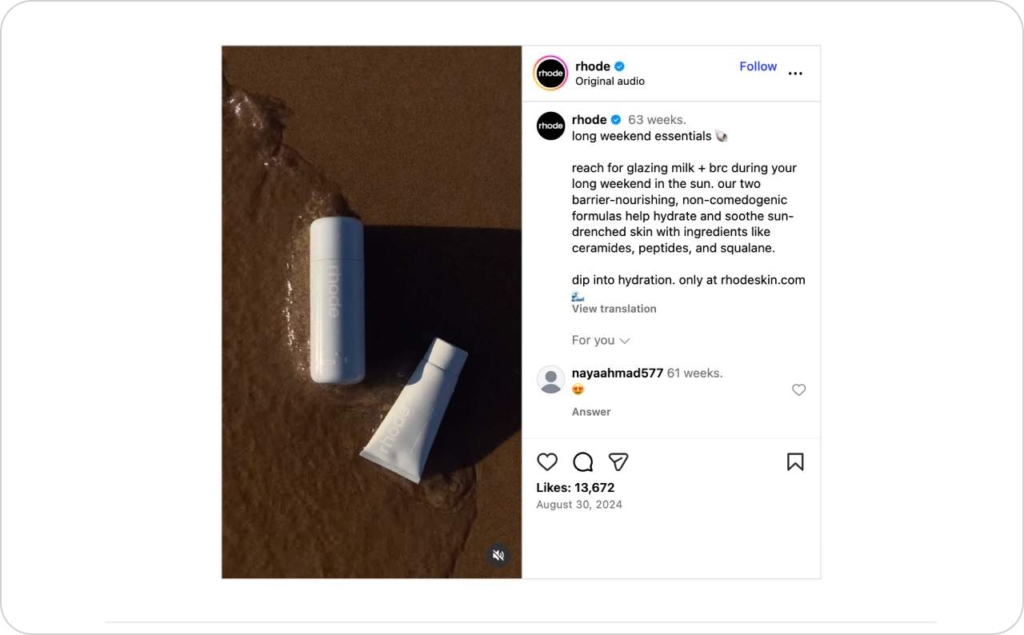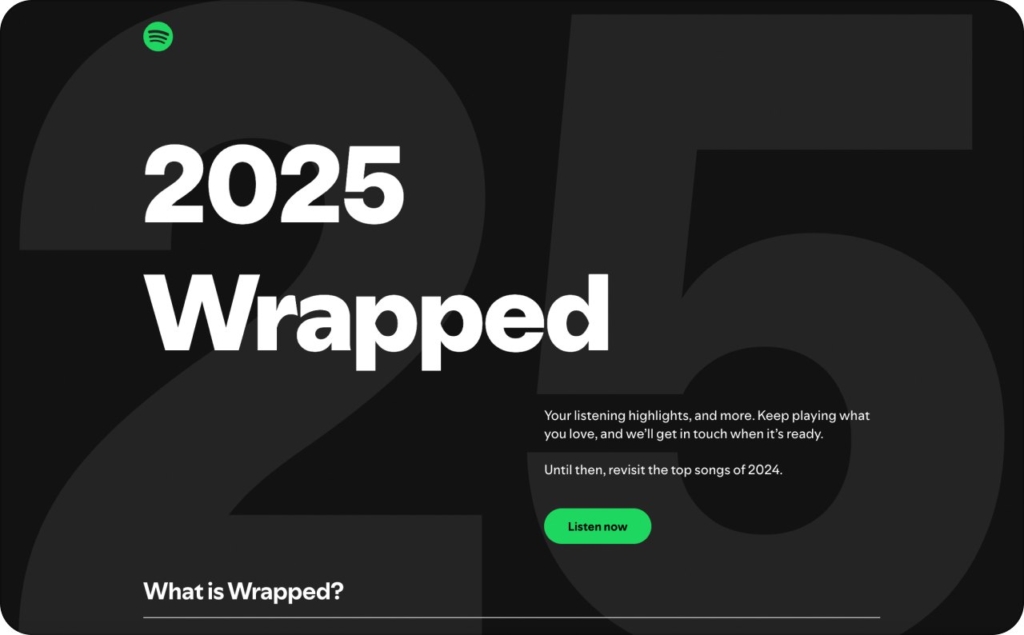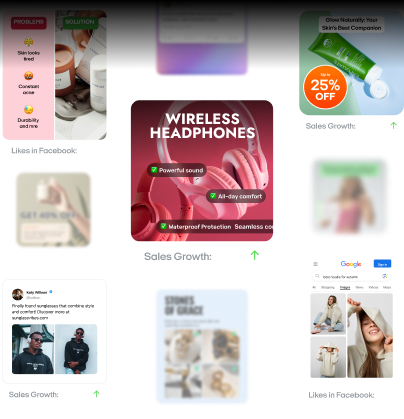15 top storytelling marketing examples: How brands tell their stories to sell
Looking for storytelling marketing examples? Check out 15 standout brand stories discovered by Zeely AI that inspire emotion, build trust, and increase sales.
What is storytelling marketing?
Storytelling marketing means telling your brand’s story like a journey people want to follow. Instead of listing features, you place the customer or the product in the lead role. Show the problem they face. Guide them to a resolution that connects naturally with your brand. The call to action feels like the next step in the story, not an interruption.
When we ask what is storytelling marketing, we are talking about how simple story elements — a character, a conflict, and a resolution — translate into measurable results. Campaigns built this way stick in memory, build trust, and make your brand easier to recall long after the ad ends.
When you tell stories this way, people don’t just see an ad — they follow a journey they want to join. Short-form video and visual storytelling now deliver the highest ROI in 2025.

Why is storytelling so effective in advertising?
Storytelling marketing works because people don’t store ads as bullet points; they store them as experiences. A well-told story sparks narrative transportation, where emotion carries the message further than logic alone. That emotional appeal translates directly into performance:
- Stories raise brand lift and recall because emotional appraisal wires memory deeper
- Story arcs improve CTR as people are more curious to see “what happens next”
- A clear resolution boosts CVR by making the CTA feel like part of the journey
- Campaigns using narrative framing often report higher ROAS from lower CPA
With 48% of North American marketers balancing revenue growth and brand awareness — and 54% cutting ad spend — story-driven campaigns deliver more with less.
The components of an effective brand story
An effective brand story gives people something to follow, not just something to buy. Three proven frameworks help:
- ABT (And-But-Therefore). “This exists. But there’s a problem. Therefore, here’s the solution.” Perfect for short ads
- 3-Act Structure. Setup, conflict, resolution. It mirrors everyday decision-making, which is why it works in video and UGC
- Freytag’s Pyramid. Exposition, climax, resolution. Best for longer campaigns with sequenced posts or episodes
Archetypes make your brand feel human. The Caregiver, the Explorer, or the Rebel each give stories a personality. A proof stack (customer testimonials, numbers, or third-party badges) makes the narrative credible. Visual grammar (colors, framing) and sonic cues (music, tone) carry as much weight as words.
This matters for growth: 71% of consumers expect personalized interactions, and three-quarters will switch if they don’t get them. A strong brand story builds that sense of recognition while guiding customers toward action.
Storytelling in marketing examples
Founder origin: Spanx — purpose turns into proof
When Sara Blakely started Spanx, she didn’t open with product specs. She shared the moment she cut the feet off her pantyhose to solve her own frustration. That small story became the heartbeat of the brand. Instead of selling shapewear, Spanx showed a relatable founder facing the same problem as her customers and creating a fix. Trust grew because the story was universal: a simple before-and-after that made sense to everyone.
Why it works
- Humanizes the company with a relatable struggle
- Creates emotional recall that builds brand lift
- Turns a personal pain point into scalable proof
How to use it in your advertising
Have your founder share the “spark moment” on video or social. Keep it short: what frustrated them, how they solved it, and what changed after. End with a call to action that links their story to what the customer needs right now.

Photo source: Spanx
Customer hero: Dove real beauty — customers as the heroes
Dove’s Real Beauty campaign changed the story by putting everyday women at the center instead of models. The ads shared real insecurities, then showed how Dove products fit into those lives with honesty. The focus wasn’t on brand claims. It was on customer voices carrying the story. By making women the protagonists, Dove turned lived experience into the message and built global trust and loyalty.
Why it works
- Elevates social proof through real voices
- Increases relatability, improving CTR and brand lift
- Builds credibility by replacing claims with experience
How to use it in your advertising
Invite real customers to share their before-and-after stories. Capture short clips that show the journey in their own words. Let the brand play the supporting role, so the spotlight stays where it belongs — on them.
Product as guide: Apple iPhone — the device as mentor
Apple’s Shot on iPhone series proves the product doesn’t need to be the star. The ads highlight striking photos and videos, while the camera itself fades into the background. The iPhone becomes the quiet guide that helps people capture extraordinary moments. By positioning the product as the tool, not the hero, Apple empowers customers to feel: with this device, I can do more.
Why it works
- Frames the product as enabling, not bragging
- Connects benefits to real-life creativity
- Builds desire by showing possibility
How to use it in your advertising
Show your product at the moment it makes a difference — the turning point that changes the outcome. Keep the lens on what the customer achieves with it, not on the specs behind it.
Mission / POV: Nike “Dream crazy” — standing for more than product
Nike’s Dream Crazy campaign with Colin Kaepernick wasn’t about shoes. It told a story of courage, identity, and standing up for what you believe in. By taking a clear point of view on a divisive issue, Nike connected with people who value boldness and social justice. The story tied brand purpose to personal identity, showing that mission-led campaigns can create deep loyalty — even when they spark controversy.
Why it works
- Creates belonging by aligning with shared values
- Boosts brand lift through emotional intensity
- Strengthens long-term loyalty and retention
How to use it in your advertising
Define a belief your brand stands for, then show it through people, not slogans. Let actions prove the mission. End with a call to action that invites customers to join.
Social impact: TOMS one for one — impact as the narrative
TOMS grew fast by telling a simple social story: for every pair of shoes sold, another was given to a child in need. It wasn’t framed as charity; it was central to the brand’s identity. The campaign showed real children receiving shoes and backed it with numbers. By linking daily purchases to visible change, TOMS turned buying into participation. Customers didn’t just wear the product — they carried the story.
Why it works
- Creates credibility by tying impact to real outcomes
- Appeals to buyers who value purpose alongside function
- Encourages word-of-mouth and sharing
How to use it in your advertising
Pair impact metrics with human faces. Let the community or cause lead, with the brand present but not dominating.
Myth-bust: Oatly — breaking the milk myth
Oatly grew by flipping dairy’s narrative. Ads like “It’s like milk, but made for humans” challenged the idea that cow’s milk was the default. The message was bold, simple, and sticky. By reframing the category, Oatly didn’t just sell oat milk — it rewired how people thought about milk itself. The product became the smarter, more modern choice.
Why it works
- Disrupts attention with surprise and humor
- Reframes consumer choice by challenging habits
- Positions the brand as a confident authority
How to use it in your advertising
Find a misconception in your space. Build a short, clear ad that flips it fast and makes the new truth easy to remember.
Behind the scenes: Glossier — growth through transparency
Glossier built its community by showing the work behind the gloss. Instead of polished ads, the brand shared team brainstorms, packaging tests, and candid clips. This behind-the-scenes storytelling made the brand feel open and human, as if customers were part of the process. By inviting people into the messy middle, Glossier turned transparency into trust and built a following that shaped its products.
Why it works
- Humanizes the company by showing the process
- Builds intimacy and trust with the audience
- Increases dwell time and engagement through curiosity
How to use it in your advertising
Share authentic, low-polish clips from your team or production floor. Add captions for clarity, but keep the tone casual and real.
UGC remix: TikTok co-creation — fans as storytellers
TikTok’s biggest brand campaigns thrive on remix culture. Instead of polished commercials, brands encourage users to create clips, then stitch or duet those into official ads. Dance challenges, hashtag contests, and brand sounds spread the story organically. By curating community voices, the brand steps back while customers move forward. Participation itself becomes the story.
Why it works
- Builds trust by amplifying real customers
- Boosts CTR and CVR through relatability
- Expands reach with minimal production cost
How to use it in your advertising
Invite users to share content under a branded theme. Edit or stitch the best clips into paid ads, keeping the community voice front and center.
Serialized streaming: Netflix “Stranger things” promos — episodic arcs that build loyalty
Netflix promotes new seasons like mini-story arcs. Trailers, teasers, and posters hint at conflicts and resolutions, building anticipation before launch. Each piece mirrors the narrative rhythm of the show, so promotion feels like part of the experience. By treating ads as chapters, Netflix keeps audiences hooked until the season drops.
Why it works
- Builds anticipation through cliffhangers
- Increases brand lift by linking promos to core product value
- Encourages repeat engagement and loyalty
How to use it in your advertising
Break a campaign into episodes: teaser, conflict, resolution. Release across channels in sequence to mimic a story arc.
Shoppable video: Instagram Reels with product tags — story + instant action
Brands on Instagram use short-form Reels to tell mini-stories, then layer shoppable tags on top. A quick narrative shows the product in action, followed by an easy path to buy. The story makes it engaging; the embedded shopping feature makes it seamless.
Why it works
- Merges storytelling with frictionless conversion
- Boosts CTR and CVR in one flow
- Keeps engagement high with entertaining content
How to use it in your advertising
Use a 15–30 second video that tells a mini journey — hook, usage, payoff. Add shoppable tags so purchase is one tap away.

Photo source: @rhode on Instagram
Influencer arcs: Gymshark — fitness journeys over time
Gymshark works with influencers who share real fitness transformations. Instead of one-off posts, they build arcs: struggle, progress, achievement. The brand supports the journey but doesn’t overtake it, making the influencer’s story central.
Why it works
- Long-form storytelling deepens trust
- Encourages repeated touchpoints with the audience
- Converts by linking product use to progress
How to use it in your advertising
Partner with creators willing to document a multi-week journey. Use UGC clips across ads, then highlight the outcome as the payoff.
Interactive polls: Spotify wrapped — personalized data as story
Spotify Wrapped turns user listening data into a narrative each December. Instead of telling a single brand story, it creates millions of personal storylines users share online. Ads extend this with playful recaps, positioning Spotify as the soundtrack to life.
Why it works
- Personalization increases shareability
- Boosts organic reach through social virality
- Creates emotional recall tied to music
How to use it in your advertising
Turn customer data into personal arcs — “your year in…” Show stats, but frame them as playful milestones. Encourage sharing with branded templates.

Photo source: Spotify Wrapped
Cause-driven short film: LEGO “Rebuild the world” — narrative for purpose
LEGO’s campaign told imaginative short stories of children rebuilding worlds with bricks. The ads used cinematic arcs: conflict, invention, resolution. They promoted creativity while reinforcing LEGO’s mission to inspire play.
Why it works
- Elevates brand beyond product ads
- Taps into emotion and nostalgia
- Boosts brand affinity long-term
How to use it in your advertising
Invest in a short film format for high-impact channels like YouTube or CTV. Center it on a mission, then let the product appear naturally within the story.
Live event narrative: Red Bull Stratos — extreme story told live
Red Bull made Felix Baumgartner’s space jump into a global event. The campaign wasn’t about an energy drink; it was about pushing human limits. Live storytelling created real-time tension, climax, and resolution, with the brand woven throughout.
Why it works
- Generates massive live engagement
- Connects brand to aspirational values
- Produces evergreen content for future campaigns
How to use it in your advertising
Tie your brand to a live-streamable challenge. Frame it with a build-up story, deliver the climax live, then reuse the content across channels.
Retargeted mini-arc: Amazon — sequential ads guiding the funnel
Amazon uses retargeted ads that feel like mini story arcs: first showing awareness content, then problem-solving demos, then personalized product nudges. Each touch builds on the last, moving people from curiosity to purchase.
Why it works
- Mimics story progression across ad sets
- Improves conversion by sequencing intent
- Keeps users engaged with fresh creative
How to use it in your advertising
Design retargeting as a narrative, not repetition. Serve intro content, then solution, then urgency-driven offer, so each ad feels like the next chapter.

Photo source: Amazon
How brands measure the ROI of storytelling campaigns
| Stage | What to measure | Why It matters | Flop | Success |
| Awareness | How many people notice and remember the story | Storytelling should lift recall before conversions appear | VTR < 20%, Reach < 50k | VTR > 50%, Reach > 500k with recall lift surveys |
| Engagement | How people interact with the story | Engagement shows if the narrative resonates | AVD < 3s, CTR < 0.5% | AVD > 8s, CTR > 1.5%, share rate > 3% |
| Consideration | Whether the story builds trust and intent | Stories should move audiences toward exploring products | CTR to product page < 0.5% | CTR to product page > 2%, positive sentiment > 70% |
| Conversion | If storytelling drives purchases or sign-ups | Resolution of the story should map to a CTA | CVR < 0.5%, CPA > $100, ROAS < 1.0x | CVR > 2–3%, CPA <$30, ROAS > 3.0x |
| Retention & Loyalty | If customers stay and re-engage | Good stories reduce churn and extend value | Repeat purchase rate < 15%, pLTV <$100 | Repeat purchase rate > 35%, pLTV >$300 |
| Advocacy | If people share the story as their own | Advocacy shows the story became part of community identity | NPS < 20, UGC volume < 50 posts/month | NPS > 50, UGC volume > 500 posts/month |
How to tell your brand’s story with an AI ad generator
Telling your story doesn’t have to mean late nights editing or staring at a blank script. With Zeely’s AI ads generator, you drop in a product link and get back ready-to-run ad scripts, visuals, and even UGC-style video that feels native on TikTok, Instagram, or YouTube. And it works: 74% of enterprises met or beat ROI goals using generative AI in 2025.
How can small businesses use storytelling in digital ads?
Storytelling marketing isn’t just for global brands with film crews. Small businesses can use the same arc — character, conflict, resolution, CTA — with tools and budgets that fit their scale. The key is to make stories feel personal and relatable.
Use your founder story
Record a 30-second video on your phone explaining why you started the business. Show the frustration, the fix, and the result. Post it as a Reel or TikTok. Cost: free.
Turn customers into heroes
Ask loyal customers to send short clips of their “before and after.” With their permission, stitch those into UGC-style ads. They’ll resonate more than polished brand claims.
Show the messy middle
Share behind-the-scenes moments: packaging an order, prepping a product, or testing something new. These glimpses make people feel part of your journey.
Keep it short and structured
Hook viewers in the first 3 seconds. Use captions for clarity. Aim for 15–30 seconds max to keep attention tight.
How Zeely helps
Zeely’s AI video ad generator can turn a product link into ready-to-post scripts, avatars, or text-to-video clips. That means small businesses get professional storytelling without editing overhead.
Tips for implementing storytelling in your strategy
Storytelling marketing works best when ads feel alive, not static. Across 1.1M ad variations, the formats that performed were the ones with fast hooks, clear arcs, and steady refresh cycles. Here’s how to put that into practice.
Lead with the right format
TikTok and Reels demand a hook in the first 3 seconds. Vertical videos in the 6–15s range pull strong engagement. Meta performs best in the 15–30s window, while YouTube rewards 30–60s arcs with room for payoff.
Refresh before fatigue sets in
Most ads wear out after 2–4 weeks. If impressions hold but CTR slides, it’s time to rotate. Quick swaps keep stories sharp.
Make stories easy to follow
Captions aren’t optional. Localize where it matters. Keep visuals and tone aligned with your audience’s context.
Measure in layers
Watch leading signals first — VTR, CTR, shares. Then check lagging ones — CVR, ROAS. This ladder tells you not just if people watched, but if they acted.
Where Zeely steps in
AI Avatars for video ads explain complex arcs simply. Text-to-Video spins scripts into fast variations. Script-to-Storyboard creates UGC-style ads that look native in any feed.
Try Zeely’s AI video ad generator with a themed template bundle and see your story come to life in ads that actually convert.
Also recommended



